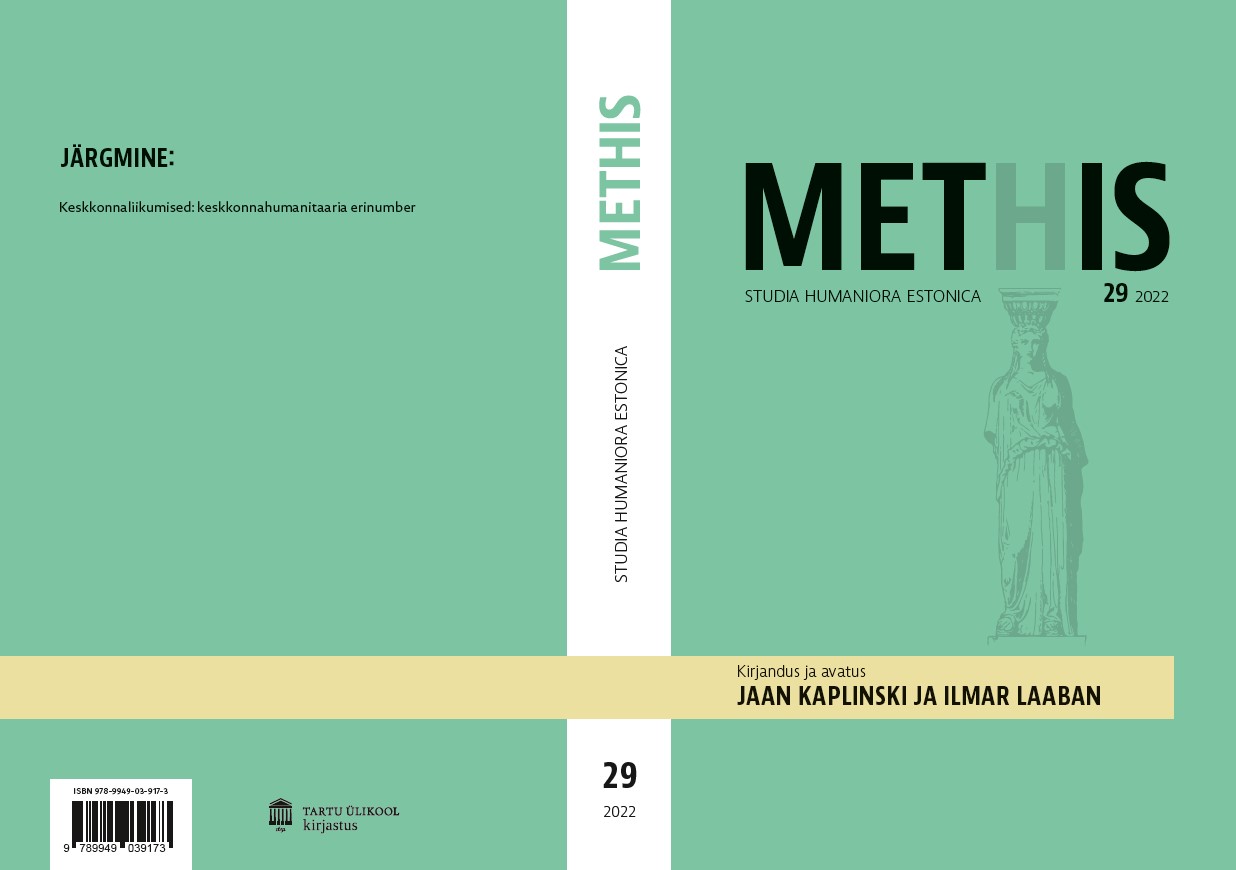Kuidas jääda ellu? Jaan Kaplinskiga antropotseenis / How Are We to Survive? With Jaan Kaplinski in the Anthropocene
DOI:
https://doi.org/10.7592/methis.v23i29.19034Keywords:
Jaan Kaplinski, antropotseen, ökoloogia, holism, keskkonnakriis, loodus, looduslik mitmekesisus, Anthropocene, ecology, holism, environmental crisis, nature, natural diversityAbstract
Jaan Kaplinski kireva loomingu kese on ökoloogiline mõtlemine. Nii tema luule, proosa, esseistika kui ka laiemalt eluhoiak põhineb dünaamilise tasakaalu otsimisel inimese ja looduse vahel. Põhiküsimus, millega ta oma loometöös tegeleb, on küsimus elu järele – kuidas elu mõista, kuidas tagada elu mitmekesisus ja jätkumine ning kuidas saavutada mõtestatud elu. Artikkel esitab visandi Kaplinski ökoloogilisest mõtlemisest, tuginedes peamiselt tema esseedele. Fookuses on küsimus, mida on Kaplinskil öelda meile praegu, keset süvenevat keskkonnakriisi: mida me saame õppida tema tekstidest eluks – ellujäämiseks – antropotseenis.
---
Ecological thinking lies at the core of Jaan Kaplinski’s (1941–2021) diverse catalogue. His poetry, prose and essays were grounded in the quest to achieve a dynamic balance between humans and nature. Life was Kaplinski’s primary focus: how it can be understood, how to ensure its continuity, and how to attain a meaningful existence.
Today, Kaplinski’s ecological writing has acquired new relevance. An ever-keener awareness of human responsibility for the environmental crisis, the declaration of a new geological era (the Anthropocene), and a re-evaluation of the relationship between nature and culture give us an opportunity to read Kaplinski from a fresh perspective.
Kaplinski’s ecological worldview essentially boils down to three principles.
The first of these is holism. As Kaplinski saw it, life forms a complete network in which everything is interconnected and interdependent. The clearest expression of this belief appeared in his 2000 travelogue Spring on Two Coasts, or A Sentimental Journey to America: “In fact, Life on Earth is not a chain, but a web, a network. If a knot or an eyelet breaks then it is still a web, albeit broken. Earth’s biosphere is currently a broken web, one so vital to us all. It is broken, but still working.” (Kaplinski 2000, 25)
Secondly, there is the principle of anti-economism. Life cannot be subjected to economic thinking, which tends to view people as creators of value, and thus believe that more work equals more value. Economic thinking leads to environmental destruction and devastation. Ecology is uneconomic. Kaplinski wrote his main essay on this topic, titled: “Ecology and Economy”, in 1972.
Thirdly, there is the principle of pluralism. In much of his writing, Kaplinski emphasised that reducing nature’s diversity weakens its self-regulating mechanisms. As a member of a tiny nation, he expressed equal appreciation for natural and cultural diversity, writing in 1972: “The biosphere is very strange and our cautious existence in it can be summarised with the slogan ‘reverence for information’. For not one genotype, community, language, or culture can be restored if they should disappear.” (Kaplinski [1972] 1996, 71)
Kaplinski’s perception of today’s global ecological situation was highly pessimistic. The preservation of natural diversity was one of his greatest concerns, as he was convinced that humankind is taking more from the environment than can be restored through its renewal. Humanity has become a force of natural destruction, which simultaneously means self-destruction.
Pessimistic diagnoses of the state of the world are abundant, to say the least. However, the value of Kaplinski’s writing for the modern readerfirst and foremost lies in his proposals for how to emerge from the crisis. In the interests of symmetry, one can select three items from his extensive catalogue.
Firstly, a shift in thinking and in imagination is required. According to Kaplinski, improving the ecological situation starts with a change in thought, by replacing economic thinking with ecological thinking. Life-endangering dreams must be replaced with ones that can cause no harm: “There are two possible courses of action: either we slow the economic engine, refrain from accelerating, and leave most of our dreams unfulfilled, or we change the dreams themselves and dream only of what isn’t dangerous to achieve.” (Kaplinski [1972] 1996, 69)
Secondly, the new self-regulation of mankind is mentioned. Kaplinski believes that it is possible to alter the relationships between humans and nature by consciously adjusting our behaviour. In his 1973 essay “Thoughts on Ecosystems and Human Culture”, he suggested that the history of human development seems to prove that we once possessed an ability to self-regulate, similar to that of other species: “If the stability of the ecosystem hinges greatly upon human activity, then man has, in principle, the opportunity to preserve or even restore stability by steering that ecosystem via his own actions. Man can govern nature by governing himself.” (Kaplinski [1973] 2004, 54)
Thirdly, and most importantly, humankind as a whole can learn how to think ecologically and consciously regulate our behaviour based on the experiences of peoples that exist within nature. Kaplinski’s ecological worldview has strong roots in anthropology and one of his primary long-term interests was searching for ties between religion and ecological thinking. In sum, Kaplinski’s message to today’s world is this: humanity’s sole chance to survive in the Anthropocene is to learn to consider all living beings as an interconnected web, to exist in a way that disturbs as few other living beings as possible, and to seek an optimal balance between our needs and the environment’s possibilities. This will require a tremendous revolution of human thought; a cultural shift that places our attitude towards nature on new foundations that lie beyond simplistic contrasts such as culture vs. nature and humans vs. animals.


